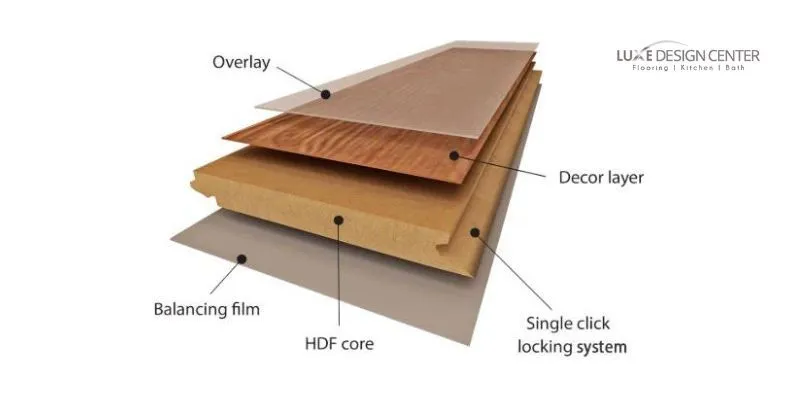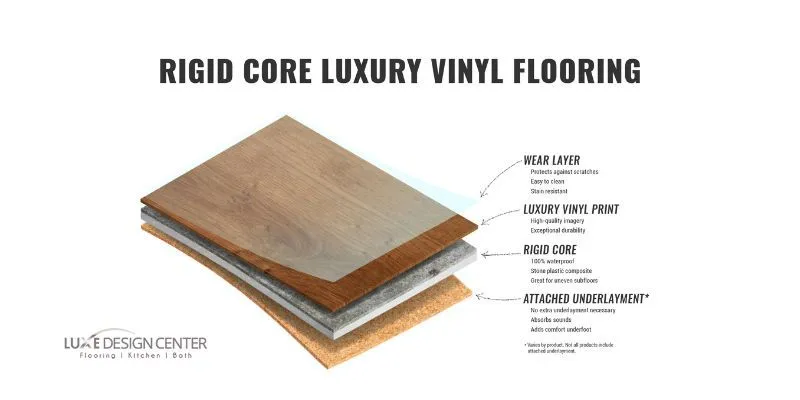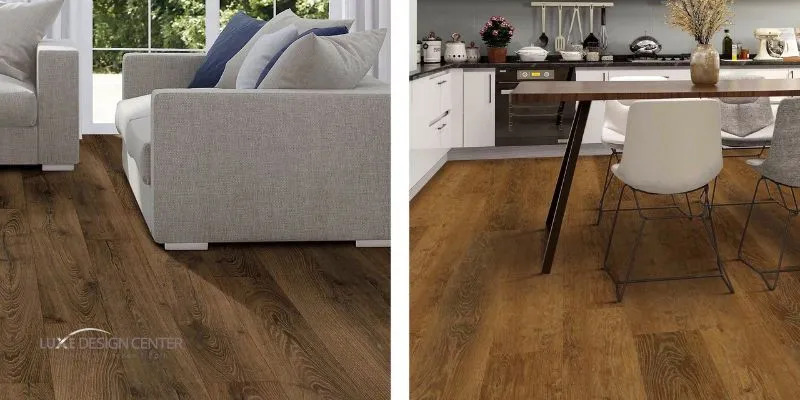When deciding on a new floor for your home, there are a broad range of options to choose from and factors to consider. From luxurious carpets to handscraped hardwoods, the options could seem endless.
In a world that seems to be chasing ever changing trends, making sure your home stands out can be challenging. Laminate and vinyl flooring are an excellent way to turn your home from trendy and fashionable to timeless and stylish without breaking the bank, but you may be asking yourself which one is most suitable for my home.
Today Luxe Design Center is breaking down the differences between laminate and vinyl flooring so you can better understand both products before making a decision.
What is Laminate Flooring?

- Layer 1: The wear layer protects the laminate from scratches, stains, and fading.
- Layer 2: A clear, high-resolution photographic image of natural hardwood, tile, or stone.
- Layer 3: A stabilizing layer that provides a structure for the laminate planks.
- Layer 4: A moisture-resistant barrier prevents liquids from seeping through the base layer.
Pros of Laminate Flooring
- Affordability: An advantage of laminate flooring is how inexpensive it is. The cost of laminate flooring tends to be less expensive than both engineered hardwood and solid hardwood floors.
- Easy Installation: Another major benefit of laminate floors is their easy click-lock installation. Most laminate flooring uses a click-lock system, allowing you to install the planks without glue or nails, making covering larger areas fairly easy.
- Durability: Laminate floors reign supreme in durability and versatility. Unlike hardwood floors, they are highly resistant to dents and scratches. They are also water-resistant, making them an excellent option for bathrooms, kitchens, and basements. However, if you’re living in an area with high humidity levels or prone to flooding, you should consider another material instead of laminate.
Cons of Laminate Flooring
- Heat sensitivity: Laminate flooring is made from wood byproducts and is sensitive to heat and light. If you live somewhere hot or sunny, you may need to think twice before installing laminate flooring.
- Difficulty refinishing: Because laminate flooring isn’t solid wood, it cannot be sanded down and refinished like hardwood can. Once it’s worn down or damaged, it would need to be replaced.
- Can’t be repaired: Once a plank is damaged, it is nearly impossible to replace individual pieces of laminate flooring.
So whether you have a big family or a busy home, laminate flooring is an excellent option for your family room, hallways, kitchen, bathroom, and bedrooms.
Related: Top Five Flooring Trends of 2021
What is Vinyl Flooring?

Vinyl is a very flexible material, making it ideal for use in various products such as vinyl siding, vinyl windows, and vinyl flooring. Since its emergence in the 1950s, vinyl flooring has been a popular choice for most homeowners, and it’s easy to see why. Vinyl is a resilient material, which means that it is resistant to surface damages, and resistant to moisture.
Vinyl flooring is versatile and can be installed on many surfaces, including concrete subfloors, hardwood floors, and tile floors.
Vinyl flooring is made up of various layers:
Layers of Vinyl Flooring

Vinyl flooring is made up of many layers:
- A transparent wear layer that protects the floor from stains and scratches.
- The printed vinyl layer gives the flooring its color and pattern.
- The transparent vinyl layer brings clarity to the printed pattern.
- The core layer is the thickest and most important part of the floor because it provides stability to the entire plank or tile. It may be made of virgin vinyl, stone plastic composite (SPC), wood plastic composite (WPC), or fiberglass.
- The bottom layer, which is a backing made of felt, fiberglass, PVC, or urethane foam.
Pros of Vinyl Flooring
- Durability: The top layer of vinyl floors is very tough, making it resistant to scratches and dents from pets, furniture, or dropped items. You’ll also find that it’s easy to clean up messes with a simple wipe down.
- Low maintenance: One reason homeowners love vinyl is that it requires minimal maintenance and care. There’s no need for special cleaners or treatments when you have this type of flooring. Just sweep and mop as needed.
- Affordability: Vinyl flooring is one of the most reasonably priced types of flooring on the market today. Its price point may be low, but its quality is high, making it a big hit if you’re on a tight budget or don’t want to spend a lot on new floors.
Cons of Vinyl Flooring
- Damage Prone: Vinyl flooring is much more susceptible to damage than laminate flooring. This is particularly true with thinner types of vinyl flooring, because it tends to be softer, it is easier to scratch or puncture.
- Replacement cost: The cost per square foot of vinyl flooring is usually less than that of laminate, because of this, it may not be worth repairing damaged vinyl flooring when it could easily be replaced.
Vinyl floors are not only a smart choice, but a stylish choice. They come in a wide range of colors and designs, making them a great option if you want to transform the look of a room without spending too much money.
Laminate vs. Vinyl Flooring: Which One Is Right for You?

Laminate and vinyl flooring are two popular options for home remodeling projects. Choosing between the two is not easy, though, and the difference in price and appearance can be very different depending on which type you choose.
Vinyl flooring comes in many different forms: roll, tile, and plank. The latter is similar to laminate because it’s a floating floor system that locks together and relies upon underlayment materials to absorb foot traffic noise and provide a cushion.
Laminate Flooring vs. Vinyl Flooring: Water Resistance
Water resistance is one of the greatest advantages of luxury vinyl tile over laminate. Because it’s completely impervious to water, luxury vinyl tile can be installed almost anywhere, and is often used in laundry rooms, bathrooms, kitchens, and even basements.
Laminate Flooring vs. Vinyl Flooring: Looks
In terms of looks, both laminate and luxury vinyl tile do a great job emulating natural materials like hardwood and stone. However, luxury vinyl tile looks more realistic than laminate flooring because its top layer is embossed rather than simply printed on.
Laminate Flooring vs. Vinyl Flooring: Durability
In terms of durability, both types of floors stand up well to heavy foot traffic and are considered residential-grade products. However, if you plan to install your floor in a high-moisture area (like a basement), it’s best to stick with luxury vinyl tiles instead of laminates.
Which One Is Right for You?
Laminate and vinyl flooring are two great options, and choosing between the two is not easy. To make the decision even more difficult, the Luxe Design Center offers a variety of options for both flooring types that fit any aesthetic. Both materials offer durability and style at a low cost. The only thing left to decide now is – which one is right for your home?